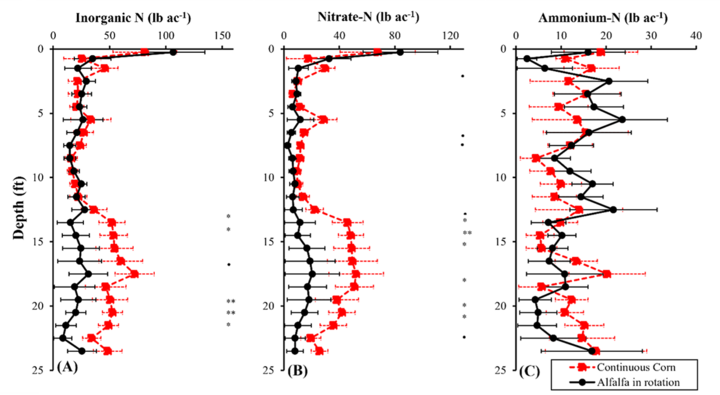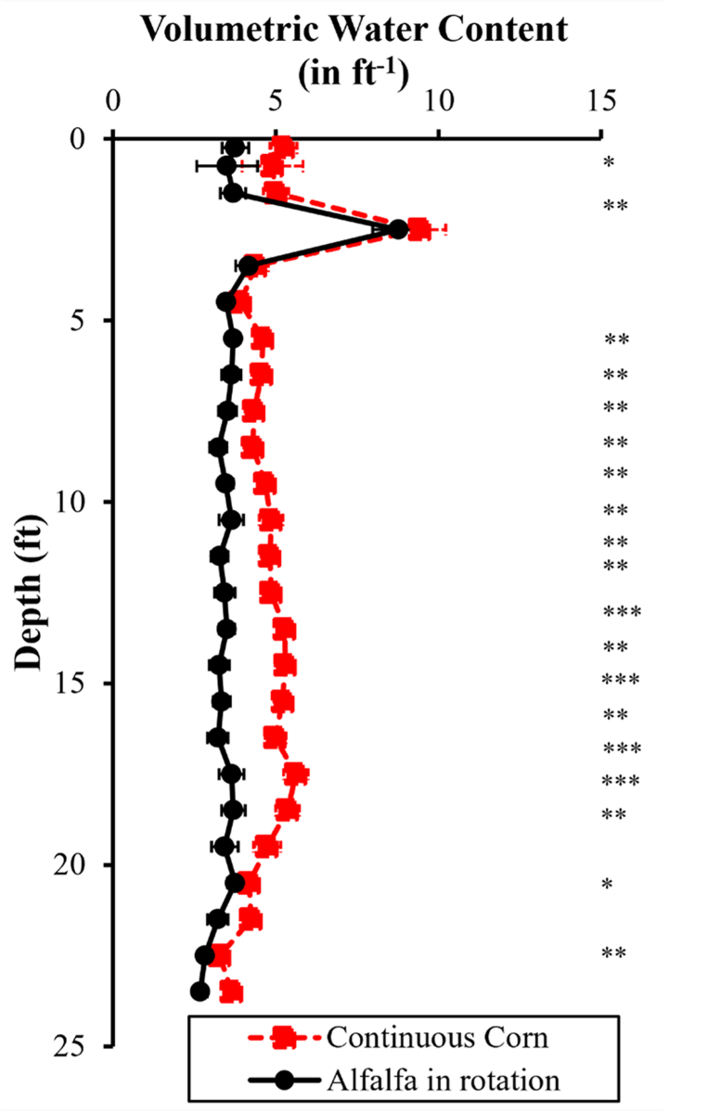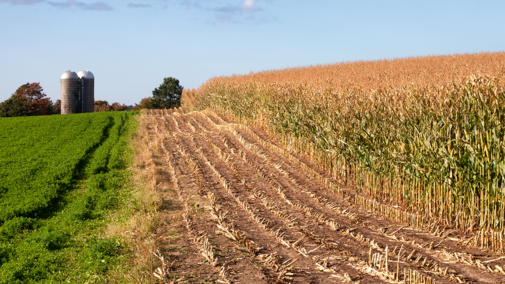Increasing nitrate-nitrogen (NO3-N) contamination of groundwater has raised significant environmental and health concerns in Nebraska. One way to reduce the nitrate contamination of groundwater is to follow best nutrient management practices (BMPs). Including a perennial crop in the annual corn-based cropping system is one of the BMPs to potentially decrease NO3-N load to the groundwater.
Including alfalfa in rotations to reduce NO3-N leaching is a long-recognized concept. Several past studies have found that alfalfa aggressively scavenges nitrogen in the soil. However, the effect of alfalfa in the rotation on NO3-N, soil organic carbon (SOC), and water content in the vadose zone remained uncertain. Therefore, we conducted a study to evaluate the impact of alfalfa in rotation with annual crops for rooting plus vadose zone to 24 feet depth (zero to 24 feet) on NO3-N and NH4-N concentration, and soil organic carbon sequestration in Nebraska (Singh et al., 2023).
The objectives of this study were to determine the impact of alfalfa rotation compared with continuous corn after 20 years on (i) NO3-N leaching potential, (ii) NH4-N, SOC, total soil nitrogen (TSN), and soil organic nitrogen (SON) in zero to 24 feet, and (iii) soil water for a subsequent annual crop. We hypothesized that for zero to 24 feet with alfalfa rotation compared with continuous corn (i) NO3-N in zero to 24 feet would be reduced, (ii) SOC, TSN, and SON will be increased, and (iii) soil water would be reduced in the root zone of a subsequent corn crop.
Experimental Measurements
The experiment was conducted at the Roman L. Hruska U.S. Meat Animal Research Center (USMARC) near Clay Center, Nebraska. The soil was well-drained and deep Crete silt loam formed in loess. The experiment was a randomized complete block design consisting of six pairs of fields with greater than 12 of the past 20 years (2001-2020) in alfalfa rotated with either corn (one to nine years in past 20 years) or soybean (zero to one year in past 20 years) (alfalfa rotation) compared with continuous annual cropping dominated by corn following corn (continuous corn) rotated with either soybean (one to three years in past 20 years) or alfalfa (zero to three years in past 20 years).
Soils from six pairs of alfalfa rotation versus continuous corn observation points were sampled to 24 feet depth in one-foot increments. The uppermost one-foot was divided into zero to six inches and six to 12 inches. The soil samples were analyzed for NO3-N, NH4-N, SOC, TSN, SON and water in zero to 24 feet.

Results on Nitrate Leaching Potential and Soil Organic Carbon Sequestration
For the zero to 24 feet depth, the alfalfa rotation compared with continuous corn had 26% less soil water (3.48 vs. 4.68-inch ft-1) and 55% less NO3-N (328 vs. 735 lbs. N ac-1), indicating less NO3-N leaching potential with less deep soil water percolation in the zero to 24 feet soil depth (Figures 1 and 2). The cropping system and NO3-N concentration did not affect NH4-N in the vadose zone (Figure 1). The greater depletion of soil water and NO3-N with alfalfa rotation was primarily below the rooting zone of corn, suggesting no negative implications for corn following alfalfa but greatly reduced potential of NO3-N leaching to the aquifer with the alfalfa rotation.

The alfalfa rotation compared with continuous corn had 47% higher SOC (47.3 ton ac-1 vs. 32.2 ton ac-1) and 23% higher total soil TSN (5.34 ton ac-1 vs. 4.34 ton ac-1) in the zero to four feet depth. The higher SOC at zero to four feet in alfalfa rotation indicates long-term potential for SOC sequestration. Increasing alfalfa in cropping systems may have more potential to increase SOC, and TSN if the SOC level is low relative to comparable field situations.
Summary
Rotation of annual crops with alfalfa is a highly effective means of reducing NO3-N leaching to aquifers and to the lateral flow of water to seepage areas with cost-effectiveness dependent on the commodity values. The 55% less NO3-N stock in the zero to 24 feet soil depth, and increased SOC, TSN and SON in the agronomically important zero to four feet soil layer with alfalfa in rotation may contribute to increased productivity and sustainability. Water quality is important to the public, and implementation of improved management practices by increasing alfalfa in crop rotations could be an effective way to protect this valuable resource.
References
Singh, A., Afzal, T., Woodbury, B., Wortmann, C., Iqbal, J. (2023). Alfalfa In Rotation With Annual Crops Reduced Nitrate Leaching Potential. Journal of Environmental Quality, https://doi.org/10.1002/jeq2.20473.
Acknowledgements
Financial support for this work was provided by the Institute of Agriculture and Natural Resources at the University of Nebraska-Lincoln, the Robert B. Daugherty Water for Food Global Institute, and the United States Department of Agriculture - Agricultural Research Services (USDA-ARS). Mention of trade names or commercial products is solely for the purpose of providing specific information and does not imply recommendation or endorsement by the USDA. The USDA is an equal opportunity provider and employer.

